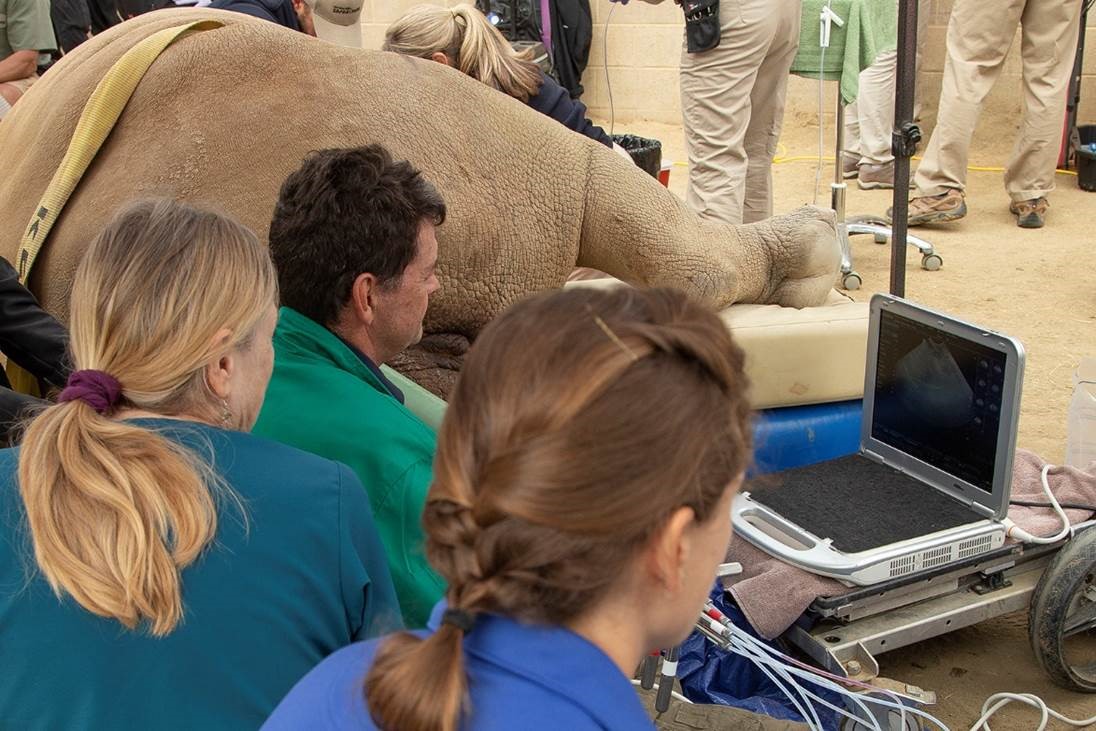
Southern White Rhino Undergoes Ovum Pick-up Procedure at Nikita Kahn Rhino Rescue Center
Researchers from San Diego Zoo Global and Embryo Plus South Africa performed an ovum pick-up (OPU) procedure on Nikita, a 9-year-old female southern white rhinoceros at the San Diego Zoo Safari Park’s Nikita Kahn Rhino Rescue Center, on March 6. San Diego Zoo Global researchers are perfecting OPU as a critical step in the conservation organization’s ongoing work to develop the scientific knowledge required to genetically recover the northern white rhino, a subspecies of the southern white rhino. This is the first time San Diego Zoo Global has used this procedure to collect eggs from a live rhinoceros.
OPU is a non-surgical method of collecting eggs from a live animal. Modeled after a common method used on cows and horses, OPU has been perfected on southern white rhinos by San Diego Zoo Global collaborator Dr. Morne de la Rey, director of Embryo Plus South Africa. Dr. De la Rey recently welcomed a team of scientists from San Diego Zoo Global to observe his work in South Africa. He then traveled to San Diego last week to further assist the San Diego Zoo Global team with the procedure on four southern white rhinos at the Safari Park.
“We are grateful to collaborate with Dr. Morne de la Ray and his team on this important step in our efforts to save the northern white rhino from the brink of extinction,” said Barbara Durrant, Ph.D., director of reproductive sciences, San Diego Zoo Global. “Having viable, fresh eggs is very important to our work. Before OPU, we have only been able to collect eggs after an older animal dies. Older eggs are not very viable; the best eggs come from a living animal. Now, our next step is to learn how to mature these eggs in culture, and how to fertilize them and grow them to the stage needed for embryo transfer.”
Throughout the OPU procedure, Nikita the rhino was anesthetized and carefully monitored by a team of more than 30 veterinarians, researchers and wildlife care specialists. Using a specialized piece of equipment developed for San Diego Zoo Global by Embryo Plus South Africa, researchers located the rhino’s ovaries with ultrasound. Then, a very tiny needle was inserted into each follicle (structure that grows eggs), safely retrieving the eggs.
Successful egg retrieval was accomplished with Nikita and the other three rhinos that underwent the procedure. After retrieval, the eggs are matured in vitro, fertilized by intracytoplasmic sperm injection (ICSI), then cultured through development to the blastocyst stage—the last stage prior to implantation of the embryo in the uterus. Traditional in vitro fertilization involves using thousands of sperm for each egg, while ICSI uses a single sperm to fertilize a single egg. Embryo transfer has yet to be successful in rhinos. Once this is perfected, embryos developed from these in vitro procedures could be transferred into one of the southern white rhinos at the Nikita Kahn Rhino Rescue Center to produce a southern white rhino calf.
To reach the ultimate goal of successfully producing a northern white rhino, multiple steps must be accomplished. One of the first steps involved sequencing the genome of the northern white rhino to clarify the extent of genetic divergence from its closest relative, the southern white rhino. The analysis revealed that they are distinct subspecies. Another step requires conversion of cells preserved from 12 individual northern white rhinos in the San Diego Zoo Institute for Conservation Research’s Frozen Zoo® to stem cells that could develop into sperm and eggs.
Reproductive options include artificial insemination, in vitro fertilization and embryo transfer, with the southern white rhinos serving as surrogates for northern white rhino embryos. The reproductive system of rhinos is very complex, and there is still much to be learned. There are many challenges ahead, but researchers are optimistic that a northern white rhino calf could be born from these processes within 10 to 15 years. This work also may be applied to other rhino species, including critically endangered Sumatran and Javan rhinos.
San Diego Zoo Global has been working on rhino conservation for more than 40 years. To learn more, visit EndExtinction.org.














